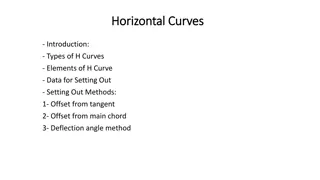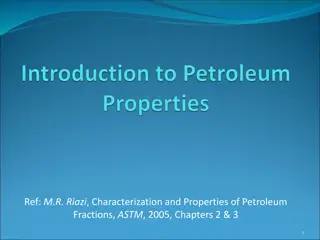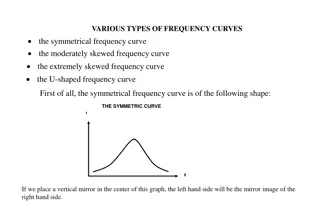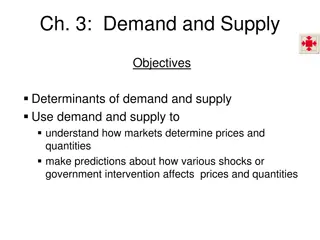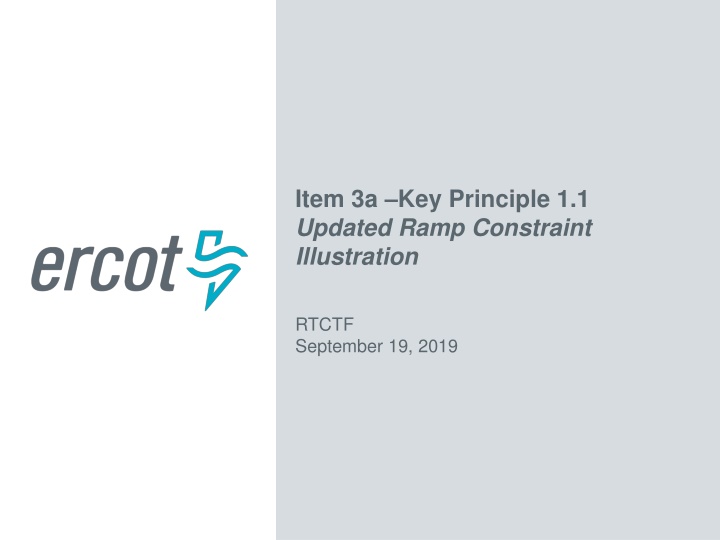
Real-Time Co-optimization and Demand Curves Discussion Example
Explore an illustrative discussion on Real-Time Ancillary Service Demand Curves (ASDCs) under system-wide scarcity conditions, comparing different approaches for setting prices and allocating reserves. Dive into examples showcasing the behavior of a system with scarcity conditions affecting Ancillary Services.
Download Presentation

Please find below an Image/Link to download the presentation.
The content on the website is provided AS IS for your information and personal use only. It may not be sold, licensed, or shared on other websites without obtaining consent from the author. If you encounter any issues during the download, it is possible that the publisher has removed the file from their server.
You are allowed to download the files provided on this website for personal or commercial use, subject to the condition that they are used lawfully. All files are the property of their respective owners.
The content on the website is provided AS IS for your information and personal use only. It may not be sold, licensed, or shared on other websites without obtaining consent from the author.
E N D
Presentation Transcript
Item 3a Key Principle 1.1 Updated Ramp Constraint Illustration RTCTF September 19, 2019
Acronyms Ancillary Service (AS) Ancillary Service Demand Curves (ASDC) ERCOT Contingency Reserve Service (ECRS) Generation-to-be-Dispatched (GTBD) High Ancillary Service Limit (HASL) High Dispatch Limit (HDL) High Sustained Limit (HSL) Operating Reserve Demand Curve (ORDC) Non-Spinning Reserve Service (Non-Spin) Power Balance Penalty Curve (PBPC) Real-Time Co-optimization (RTC) Real-Time Co-optimization Task Force (RTCTF) Regulation Up Service (Reg-Up) Responsive Reserve Service (RRS) Security-Constrained Economic Dispatch (SCED) Security-Constrained Economic Dispatch Up Ramp Rate (SURAMP) 2 PUBLIC
Introduction During the August 27, 2019 RTCTF discussion on Real-Time ASDCs, there was a desire to look at the same illustrative examples under a system-wide scarcity condition. This was is addition to the ramp-constrained system condition that was presented. The group also wanted to discuss the pros and cons of the two approach 1. The approach of basing a portion of the Reg-Up and RRS ASDCs on the current PBPC. 2. The approach of stacking all Reg-Up ahead of RRS, all RRS ahead of ECRS, and all ECRS ahead of Non-Spin 3 PUBLIC
Example Setup This presentation again uses a simplified example to illustrate how a system would behave under: A. RTC where the ASDC for Reg-Up is placed within an aggregate ORDC based on a PBPC; and B. RTC where the ASDC for Reg-Up is placed at the highest price points of the aggregate ORDC without consideration of the PBPC. The system: Resources - One generator (Resource A) that has an HSL of 100 MW and a ramp rate of 1 MW/min AS - There are two AS products: Reg-Up and ECRS, both with an AS plan of 3 MW PBPC 10,000 8,000 $/MWh 6,000 4,000 2,000 0 0 0.5 1 1.5 MW 2 2.5 3 4 PUBLIC
RTC Examples Aggregate ORDC 10,000 8,000 $/MWh 6,000 4,000 2,000 0 0 1 2 3 4 5 6 MW All Reg-Up is placed at price points on the aggregate ORDC ahead of ECRS Reg-Up is set exactly equal to the inverse of the PBPC ASDCs - Example B ASDCs - Example A 10,000 10,000 Reg-Up ECRS 8,000 8,000 Reg-Up $/MWh $/MWh 6,000 6,000 ECRS 4,000 4,000 2,000 2,000 0 0 0 0.5 1 1.5 MW 2 2.5 3 0 0.5 1 1.5 MW 2 2.5 3 5 PUBLIC
RTC Example A Key points: In interval 2, start seeing scarcity pricing driven by ASDCs Initially only short on ECRS For interval 3, we now see shortages in both Reg-Up and ECRS, but neither are fully exhausted For interval 3, the ASDCs set the AS prices at $9,000/MWh Note: ERCOT s KP 1.1 proposal does not price any ECRS or Non-Spin at $9,000/MWh ASDCs - Example A 10,000 Reg-Up ECRS 8,000 $/MWh 6,000 4,000 2,000 0 0 0.5 1 1.5 MW 2 2.5 3 Ramp constraint: HDL = Output + (1MW/min * 5min) = Output + 5MW Base Point + (50% * Reg-Up Award) <= HDL Resource A Real-Time Interval GTBD/ Demand HDL Reg-Up Award ECRS Award HSL/ HASL (Physical Ramp) Base Point 1 94 3 3 100/na 96.5 94 2 96 3 1 100/na 99 96 3 98 1.2 0.8 100/na 100 98 4 96 3 1 100/na 100 96 6 PUBLIC
RTC Example B Key points: In interval 2, start seeing scarcity pricing driven by ASDCs Initially only short on ECRS For interval 3, we now see shortages in both Reg-Up and ECRS, but more Reg-Up awarded compared to example A since ECRS is now fully exhausted For interval 3, the Reg-Up price is at $9,000/MWh and the ECRS price is at $2,000/MWh ASDCs - Example B 10,000 8,000 Reg-Up $/MWh 6,000 ECRS 4,000 2,000 0 0 0.5 1 1.5 MW 2 2.5 3 Ramp constraint: HDL = Output + (1MW/min * 5min) = Output + 5MW Base Point + (50% * Reg-Up Award) <= HDL Resource A Real-Time Interval GTBD/ Demand HDL Reg-Up Award ECRS Award HSL/ HASL (Physical Ramp) Base Point 1 94 3 3 100/na 96.5 94 2 96 3 1 100/na 99 96 3 98 2 0 100/na 100 98 4 96 3 1 100/na 100 96 7 PUBLIC
High-Level Pros/Cons of the Approaches RTC where the ASDC for Reg-Up is placed within an aggregate ORDC based on a PBPC In a ramp-constrained system condition, you will avoid system-wide capacity scarcity pricing for minor ramp scarcity conditions. However, in a system-wide capacity scarcity condition, Reg-Up would only be given partial priority over the other AS products. RTC where the ASDC for Reg-Up is placed at the highest price points of the aggregate ORDC without consideration of the PBPC In a ramp-constrained system condition, you may see system-wide capacity scarcity pricing for even minor ramp scarcity conditions. However, in a system-wide capacity scarcity condition, Reg-Up would be given complete priority over the other AS products. 8 PUBLIC
Appendix Material presented at the August 27, 2019 RTCTF Meeting PUBLIC
Introduction During the 8/9/19 RTCTF discussion on Real-Time ASDCs, there was a need for an example looking at pricing outcomes during a ramp- constrained system condition. Questions that were posed: What are the theoretical effects of basing the Reg-Up ASDC on the PBPC as opposed to having all Reg-Up placed at the highest price points of the aggregate ORDC? If the ASDC prices points are higher for one AS product than another AS product, it is guaranteed that the latter AS product is fully exhausted before being short on the first AS product? 10 PUBLIC
Example Setup This presentation uses a simplified example to illustrate how a ramp-constrained system would behave under: A. Today s market design; B. RTC where the ASDC for Reg-Up is placed within an aggregate ORDC based on a PBPC; and C. RTC where the ASDC for Reg-Up is placed at the highest price points of the aggregate ORDC without consideration of the PBPC. 11 PUBLIC
Example Setup A ramp-constrained system condition is referring to a case where there is sufficient supply capacity on the system relative to demand, but there is not sufficient ramp capability that is available for the horizon of the 5-minute dispatch interval. The system: Resources - One generator (Resource A) that has an HSL of 100 MW and a ramp rate of 1 MW/min AS - There are two AS products: Reg-Up and ECRS, both with an AS plan of 3 MW Assume 50% ramp sharing between energy and Reg-Up 12 PUBLIC
Todays Market PBPC Key points: AS responsibilities can t be moved. For interval 3, the ramp limitations result in going 0.5 MW into the PBPC. Accordingly, price goes to $2,000/MWh based on the PBPC. Theoretically, Reg-Up is deployed to account for the missing energy. 10,000 8,000 $/MWh 6,000 4,000 2,000 0 0 0.5 1 1.5 MW 2 2.5 3 Ramp constraint: SURAMP = 1MW/min ((3/5)*50%) = 0.7MW/min HDL = Output + (0.7MW/min * 5min) = Output + 3.5MW Resource A Real-Time Interval GTBD/ Demand Reg-Up Responsibility ECRS HSL/ HASL HDL (SURAMP -Based) Base Point Responsibility 1 2 70 73 3 3 3 3 100/94 100/94 71 73.5 70 73 3 77 3 3 100/94 76.5 76.5 4 79 3 3 100/94 80 79 13 PUBLIC
RTC Examples Aggregate ORDC 10,000 8,000 $/MWh 6,000 4,000 2,000 0 0 1 2 3 4 5 6 MW All Reg-Up is placed at price points on the aggregate ORDC ahead of ECRS Reg-Up is set exactly equal to the inverse of the PBPC ASDCs - Example B ASDCs - Example A 10,000 10,000 Reg-Up ECRS 8,000 8,000 Reg-Up $/MWh $/MWh 6,000 6,000 ECRS 4,000 4,000 2,000 2,000 0 0 0 0.5 1 1.5 MW 2 2.5 3 0 0.5 1 1.5 MW 2 2.5 3 14 PUBLIC
RTC Example A Key points: AS awards can now change. For the entire window there is sufficient 10-minute ramp and capacity for energy and all AS, so no ECRS shortages regardless of the ASDC For interval 3, the ramp limitations result in being 1 MW short on Reg-Up. Accordingly, price goes to $2,000/MWh based on the ASDC. Ramp constraint: HDL = Output + (1MW/min * 5min) = Output + 5MW Base Point + (50% * Reg-Up Award) <= HDL ASDCs - Example A 10,000 Reg-Up ECRS 8,000 $/MWh 6,000 4,000 2,000 0 0 0.5 1 1.5 MW 2 2.5 3 Resource A Real-Time Interval GTBD/ Demand HDL Reg-Up Award ECRS Award HSL/ HASL (Physical Ramp) Base Point 1 70 3 3 100/na 72.5 70 2 73 3 3 100/na 75 73 3 77 2 3 100/na 78 77 4 79 3 3 100/na 81.5 79 15 PUBLIC
RTC Example B Key points: AS awards and base points are the same as in example A. With the same shortage for interval 3, the Reg-Up ASDC sets the price at $9,000/MWh. This value is higher than any point on the ECRS ASDC, but there is not an ECRS shortage ASDCs - Example B 10,000 8,000 Reg-Up $/MWh 6,000 ECRS 4,000 2,000 0 0 0.5 1 1.5 MW 2 2.5 3 Ramp constraint: HDL = Output + (1MW/min * 5min) = Output + 5MW Base Point + (50% * Reg-Up Award) <= HDL Resource A Real-Time Interval GTBD/ Demand HDL Reg-Up Award ECRS Award HSL/ HASL (Physical Ramp) Base Point 1 70 3 3 100/na 72.5 70 2 73 3 3 100/na 75 73 3 77 2 3 100/na 78 77 4 79 3 3 100/na 81.5 79 16 PUBLIC
Conclusions Questions: What are the theoretical effects of basing the Reg-Up ASDC on the PBPC as opposed to having all Reg-Up placed at the highest price points of the aggregate ORDC? With a Reg-Up ASDC where Reg-Up is placed at the highest price points of the aggregate ORDC: In a ramp-constrained system condition, you may see system-wide capacity scarcity pricing for even a minor ramp scarcity condition. However, in a system-wide capacity scarcity condition, Reg-Up would be given priority over the AS products. If the ASDC prices points are higher for one AS product than another AS product, it is guaranteed that the latter AS product is fully exhausted before being short on the first AS product? No, this is not guaranteed. One reason for this is the fact that the individual AS products all have different definitions, like time for the Resource to respond (e.g., 5 min vs. 10 min). 17 PUBLIC
Questions PUBLIC




